2024-05-13 hits:0 source:News

1.3 # Zinc alloy
No.3 zinc alloy has always been the preferred material in the die-casting industry. It can balance physical and mechanical performance requirements, has good casting and flow properties, and strong product size stability. Moreover, No.3 zinc alloy is suitable for various surface treatment processes.
2.4 # Zinc alloy
The copper content of No.4 zinc alloy is between 3 # and 5 #. No.4 zinc alloy is more effective than No.3 zinc alloy in reducing some mucosal phenomena in die castings, while No.4 zinc alloy maintains the softness of No.3 zinc alloy. Generally, it is used very little in the die casting production process.
3.5 # Zinc alloy
No. 5 zinc alloy has higher hardness and strength than No. 3 zinc alloy, but lower flexibility. If die castings require deformation processes such as rolling, bending, and dimpling, they may be affected to some extent. The characteristic transformation of No. 5 zinc alloy is due to the addition of No. 1 copper. The casting performance of No. 5 zinc alloy is excellent, and its resistance to creep (deformation under high temperature stress) is better than that of No. 3 zinc alloy. It is also suitable for electroplating, cutting processing, and general surface treatment.
4.2 # Zinc alloy
Among various low aluminum zinc alloys, the one with the highest hardness and strength, which has a high copper content (3%), will cause changes in the alloy's properties during aging, including increased size, reduced ductility, and impact strength.
Read recommendations:
stock aluminum extrusion profiles
aluminium profile for kitchen cabinets
lf you have any questions or comments, you can leave us a message and we will reply to you as soon as possible
